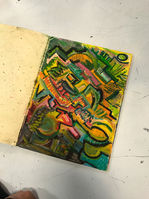stefanie vd merwe
Subjective Objects
Subjective Objects
Subjective Objects
Subjective Objects
Subjective Objects
Subjective Objects
Subjective Objects
Subjective Objects
Subjective Objects
Figurative drawing and sculpture
sub-unit 1
LESSON 1
To begin investigating and putting ourselves in the perspective of a sculpture artist, we took part in model figurative drawing art workshop where we made sketches of live subjects in different positions. The first subject was drawn in a stick-like style, to get the basic shape of the subject and the position they were in. Next we did a fast paced sketch of another live subject in a different position, and used charcoal to refine edges. Finally, with a new subject and position, we utilised a mapping technique to show our understanding of distance and dimensions.



LESSON 2
Following on from the previous lesson, we further implemented our new knowledge and understanding of figurative drawing, by drawing and sketching a "body part under tension". We decided to refer to images where muscle tension and vein definition were present as this would be much more interesting to depict further in our sculpture. I took an image online to refer to, where I felt there was a lot of good tension represented, in which I attempted to sketch.
Following 5 minutes of sketching, I was now going to try and represent this in a sculpture with the use of simple materials like cardboard, masking tape and gum strip tape. I did this by breaking, bending, folding, rolling, tearing pieces of cardboard and attaching them with one another to create a sculpture of a hand under tension. To represent tension, I tried to bend the "fingers" of the sculpture in a defined way to show the odd position of the fingers when under tension.
Here was the base of my hand sculpture;
And here was the final outcome of the sculpture;
WWW:
1. Sketch of sculpture beforehand, as I believed I had a good understanding of dimension and good accurately represent tension.
2. The basic shape of a hand was achieved with the cardboard.
EBI
1. More time dedicated to the tension aspect, and the overall representation of the hand (i.e. fingers could have had more attention).
2. More appreciation of the cardboard material, by creating more textures, and using the material productively.











Saul Cumiskey

















